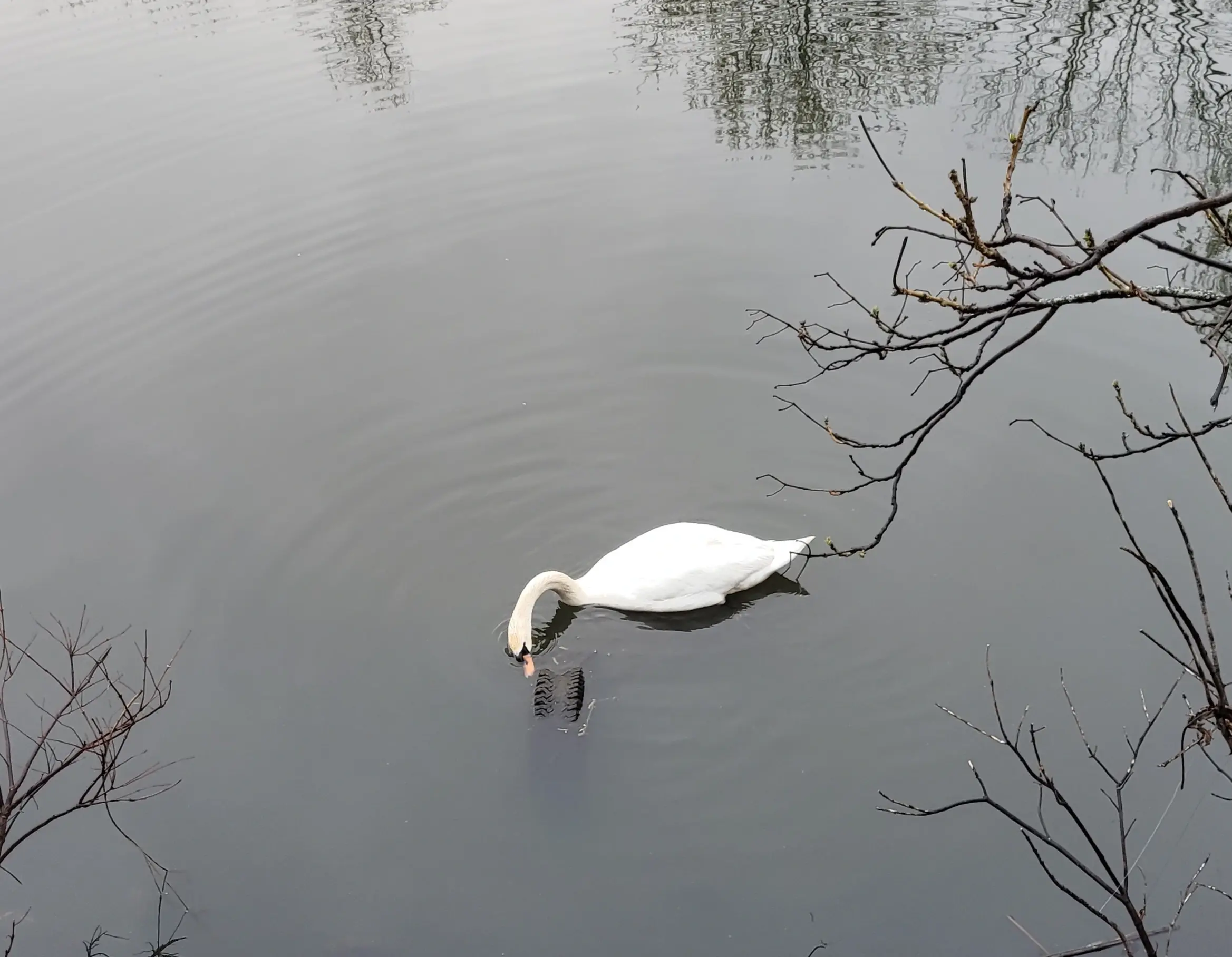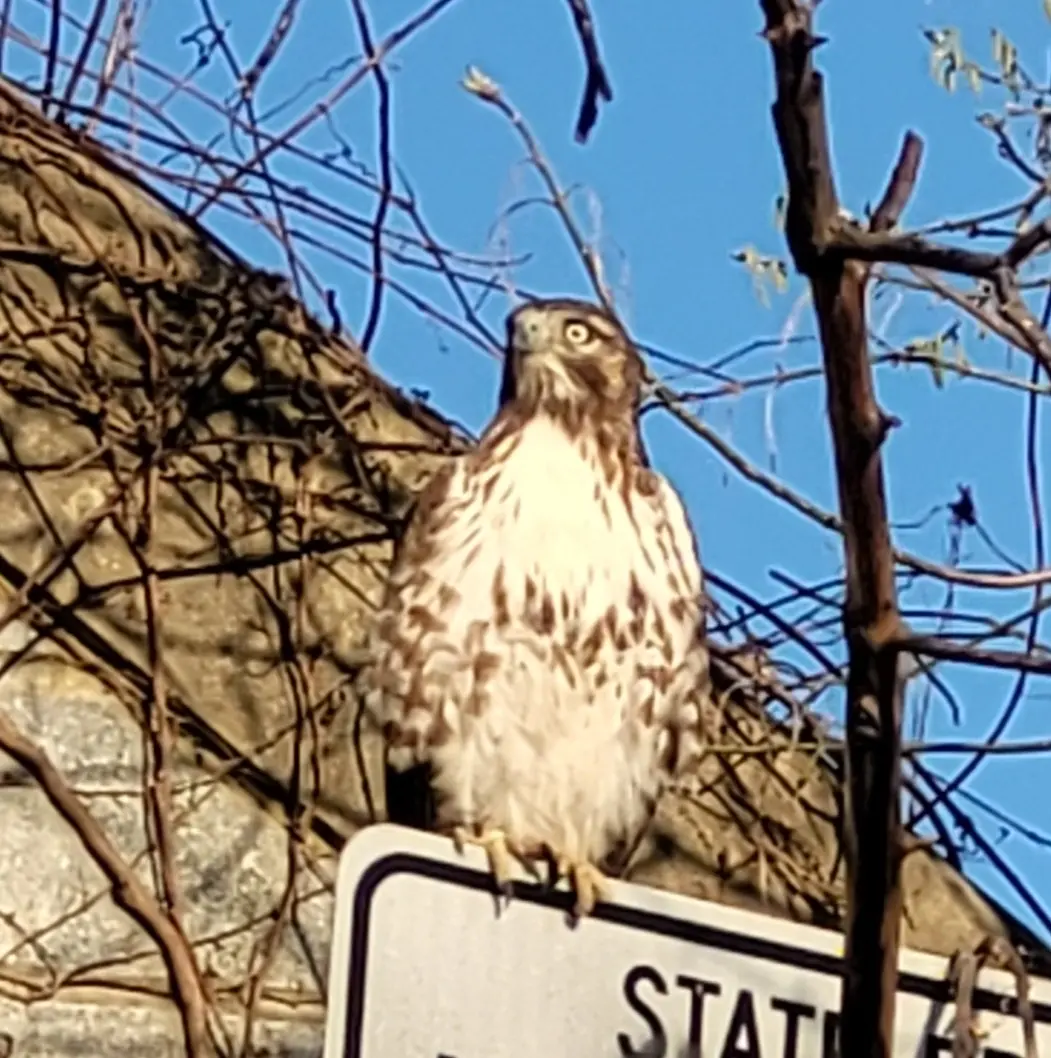 JacobCoffinWrites @slrpnk.net
JacobCoffinWrites @slrpnk.net I write science fiction, draw, paint, photobash, do woodworking, and dabble in 2d videogames design. Big fan of reducing waste, and of building community
https://jacobcoffinwrites.wordpress.com
Thanks! That reminds me: one thing I did on the second and third book blocks was clamp them further in, so they were more or less flush with the boards. (I think the bookbinding book said to let it stick out a bit). That let me compress the spine an extra millimeter or two, so it wasn't as flaired as on the first one. I think it's always going to be a little thicker on the spine side because of all the folds and thread, but I think this looks better.
Thank you so much! I'm very grateful for the sheer amount of high quality guides and resources available for free - the bookbinding community seems to be very generous with their knowledge. I basically just read and followed them carefully. I'm also lucky to have access to some great workspaces/tools.
My first bookbinding project - a hardcopy of the Fully Automated! TTRPG Rulebook
I recently started trying to learn bookbinding (and because I never liked practicing by making…
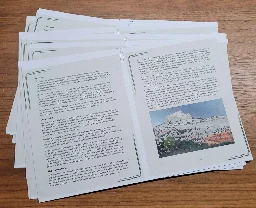
I recently started trying to learn bookbinding (and because I never liked practicing by making something I didn't need, I'm starting with a 266-page solarpunk TTRPG rulebook I helped make).
I joined the Fully Automated discord a while back, mostly because I was looking for a place to talk worldbuilding in the genre. I read the lore/setting part of the rulebook and it actually helped me start thinking bigger than I had been around ways the world could be better. If there's a solarpunk timeline from our modern day, through conflicts and crumbles and collapses, gradually rebuilding towards something eutopian, then they're much closer to that high-tech, post-scarcity end-state than the solarpunk stuff I normally write. But there's something kind of fascinating about that world, and it makes for a great place to tell stories.
I offered them the use of the art I'd already made, and then I got involved in writing and editing the lore, including contributing a couple sections around rural areas and reuse, which, true to form, they expanded into something bigger than I had come up with on my own.
Since the game is an open source, all-volunteers thing, we didn't do a print run, just released a series of PDFs. But I have free access to a printer that can do 11x17, a plotter printer that can print on canvas, my SO's unused bookbinding kit, and enough patience to learn to bind at least a few copies, so I decided to give it a try.
The first step was rearranging the pages into signatures. These are small pamphlets of folded papers that get sewn and glued together to form the book. This turned out to be way easier to do than I expected, as there are several online tools for interposing PDFs. I found and really like this one: https://momijizukamori.github.io/bookbinder-js/
This allowed me to take the regular letter-sized (8.5"x11") PDF and rearrange it into signatures of four or five 11"x17" pages, with two pages per side. It handled reordering the pages so they work correctly once the signature is folded together and stacked with the others. We also took these interposed files and made them available on the FA! website.
Once I had the interposed version, I could print off the signatures:
I really recommend printing each signature separately so you can paperclip them together and keep careful track of which pages are inside it. It's really, really easy to completely lose the plot on the numbering - I almost couldn't figure out how to put a four-page signature back in order once or twice, if it had been mixed with other ones I'd have been really confused. But it's easy as long as you keep them in their sets and remember which side is up (because its the only sheet/side where two page numbers show in order).
The free printer I had access to couldn't print without leaving a margin so I had to trim them by hand. I started off using a papercutter on the short sides, but eventually switched to using a straightedge and scalpel on all the sides.
The next step was folding the signatures folio-style using a bone folder:
And then punching holes so I could sew them together. Some guides have you sew each signature separately, then sew those together, but the one I followed (and recommend) does them all at once.
The folded piece of paper is a template marked and punched so all the holes in all the signatures line up as closely as possible.
Next, I sewed it together using the Penrose Press guide, being careful to pull the threat as tight as I could before tying it off on each signature. I really like how secure this seems to make the binding.
Even if you tie it tight though, it'll still have some gaps. That's were clamping and gluing it helps! The guides I followed suggested just stacking books for weight at this part, but I went ahead and built a really ugly book press with a piece of scrap particleboard, scrap 2"x4", some wax paper, and a couple deck screws. I pre-drilled the holes, wrapped the boards in the wax paper, and screwed them together so the book block could be clamped between them:
That's when scope-creep hit and I switched plans from making this first copy a softcover book to making a hardcover.
I followed my SO's bookbinding book, and this guide for the spine, and added a section of cheesecloth (in place of mull, which I didn't have) and manila paper in roughly the dimensions they specified. These help hold the spine together and attach it to the cover (called the case).
Next, I roped the Fully Automated folks into making a back cover for me, and I put together a printable version with a spine and everything. I took a lot of measurements, made my best guess, then went to our local makerspace to print it on their plotter printer:
It's slightly large but I'm happy with it!
The next steps came pretty much entirely from this guide.
I cut some bookboard (stiff cardboard) to size, and did my best to line it up with the image showing through the canvas. Once I had them in place, I traced them lightly onto the back of the canvas in pencil, held it up to the light to see if it was good, and made corrections until I had good lines. Then I measured out to the edges of the sheet and trimmed it down:
Then I glued the bookboard to the canvas:
I forgot to take some pictures for the next step (sorry) so you'll have to rely on my descriptions. First I cut the corners off the cover at a 45 degree angle 1/8" out from the corner of the bookboard. I used a carpenter's square to mark the angle. Then I folded the sheets over the bookboard and glued them.
Then it was time to glue the book block into the case. This happened fast enough that I didn't dare stop to take pictures. I slipped some wax paper between the endpaper (a blank sheet I included on front and back when I used the interposing software) and the rest of the book block. Then I painted it with glue as quickly as possible, being careful to first glue the cheesecloth to the paper, then painted it over with glue as well. Then I carefully closed the cover onto the sheet. The endpaper was just about a liquid at that point, despite how lightly I stippled on the glue, so I'm glad I didn't have to try to make changes. I flipped it, and let it dry for awhile.
Then I repeated those steps on the other side and left a heavy laptop sitting on it.
Its always tense waiting while the glue dries on a project, hoping its not clamped crooked, or the glue isn't running and sticking to something it shouldn't. Especially when you're combining the end result of two other projects. Luckily this one turned out mostly okay:
I can see where the endpapers stretched (just like one guide said they would) causing them to reach further towards the fore-edge than I'd have liked. But it generally looks pretty smooth and clean so I'm not very bothered by that.
All in all, I think not bad for my first bookbinding project!
Just made my first grocery run with the modified mountain bike!

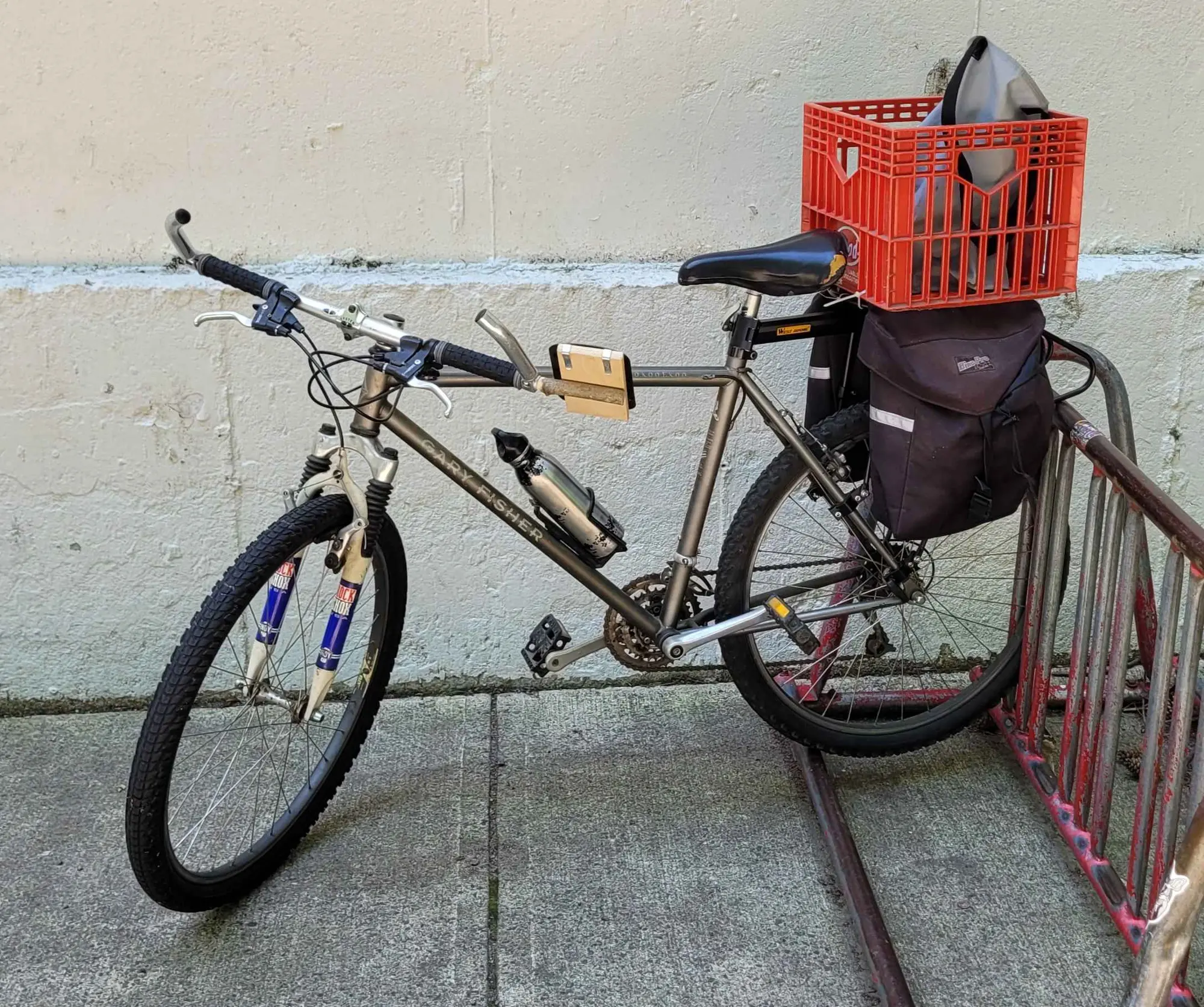
I've made a few trips to the hardware store and other errands over the years, using a backpack on my bike (years ago, when it was my only transportation, I hauled a small amount of groceries in a backpack and just made multiple trips) but this is the first trip I've made since I started trying to turn this mountain bike into a cargo bike. I've got the rear rack I talked about in that post, some basic secondhand fabric panniers secured with straps and zip-ties, and a milk crate from a consignment shop. I went for a pretty light grocery run for the first trip, just two totes of frozen stuff, and it rode just fine on the way home.
Thanks for all your advice! I think I'm going to upgrade to bucket panniers at some point soon, but I'm glad I can at least start using it like I'd planned.
Years ago I wanted to buy a new small pickup truck and couldn't find one. I would have loved to buy a small, practical Ford Ranger but they weren't available because Ford was gaming the system with vehicle sizes. Eventually I just gave up and reexamined my priorities in a vehicle.
Yeah my first reaction at just the headline was "yeah people fall off bikes, what's actually happening to cause a recall?"
Launch hazard? Vehicle breaks in half hazard?
Just updating to note that I've acquired two square buckets and am going to start this build. Thanks again!
Thanks! I appreciate it!
I just appointed you as a mod, which I think is the first moderation action I've had to take in the year I've been on Lemmy. (I love how chill this instance is, especially in the three communities I'm nominally a mod of). It's a good community and I'm glad to have another set of eyes on it in case anything does come up.
For tools, I like the idea of a harness with robot arm (perhaps similar to the arm on the Boston dynamics robot dog) designed to be lightweight but useful for when they have to interact with human-centric designs out in the world (elevator buttons, doorbells, doorknobs/keys, things on higher shelves, etc).
They also pointed out different handle materials being important if you're just using your mouth to grip things a lot of the time.
While I agree it's mostly an unwise place to buy real estate or leave your possessions (just like any flood plane) I'm curious what makes it worse for EVs than for any other car (all of which are now rife with electronics and made of the same metals). Flooding will 'total' just about any car.
Or paint it red so it can go faster. With enough boyz inside all believing as hard as they can, that thing should be zipping around the galaxy. Don't have to be sneaky if you're fast.
That's awesome and I'm totally going to do this. I'd been looking for some kind of basket or other hard pannier I could just drop the regular grocery totes inside, I should have thought of this.
This isn't the original, but I took the photo and cleaned it up a bit:

Almost a year ago I started trying to write solarpunk fiction and got daunted by the amount of research I needed. Writing scifi had always meant extrapolating current trends and pointing out problems. To do solarpunk I had to be able to offer solutions and that meant lots and lots of reading to learn from the folks who've been talking about and trying out alternative ways of doing things (from agriculture to infrastructure to anarchy) and thinking through their answers.
For awhile I did a worldbuilding art/essay project focusing on very small glimpses of a solarpunk future, trying to emphasize things like creative reuse, industry, and seasons/weather that didn't show up much in solarpunk visual art. The narrow focus helped a lot.
I think I'm finally comfortable trying to write something, though instead of a short story I'm working on a campaign for the solarpunk TTRPG Fully Automated, where the players are on a treasure hunt for tons of industrial waste which were illegally dumped sixty years before. The waste is valuable because it's a useful input in the production of geopolymers, and the stakes are high as the largely-abandoned rural town they're searching is in the process of being deconstructed and rewilded, so nobody else is likely to notice it in the future.
I've had a lot of fun building a wide swath of locations, communities, and means of travel for the players to possibly explore, along with the rough outline of the decades-old conspiracy and coverup murder.
My goal is to build out the characters, build out the past/conspiracy, and to start seeding people and locations in the present with clues for that mystery.
Yeah I'll swap it for something smaller/lighter, and the set of panniers I already have (though I think their current strap/hook configuration seems like an accident waiting to happen so I'll probably mess with that too)
I think a milk crate is a good call.
I'd thought about doing something like that with the basket - to modify it so it hung on either side like panniers/saddlebags, and I could just drop the regular grocery totes into it. I wouldn't mind the welding practice, though I'll probably start with the secondhand cloth panniers first and go from there.
A bit of progress on converting my mountain bike to a cargo bike (rear rack added with simple modification)
I posted to the slrpnk.net utility cycling community a little while back looking for advice on…

I previously posted looking for advice on turning my old steel-framed mountain bike into something I could use to haul groceries and maybe some bits of furniture I find on trash day.
I got a ton of helpful suggestions, and started out on what I think will be a gradual project as I make incremental improvements to this bicycle.
Step 1 was adding a rear rack, so I could add cargo panniers, or a basket behind the seat.
I settled on this one because I liked the extra support legs, and because it claimed to be able to support more weight than most other designs (something I remain skeptical about, but I'm pleased with the overall construction so far).
I did find that the right side seat stay was too crowded for two of the wraparound attachments to fit, so I'd need to use the built-in attachment point just above the rear gear.
Unfortunately, the lower support rod segment was too short to reach the attachment bolt. But that was fixable - the rod was just a length of 3/8 steel round stock with a flattened section where it bolted to the wraparound attachment bracket. It would be pretty easy to make one of my own.
I started by buying some 3/8” steel rod and a fresh can of propane for my offbrand bernzomatic torch (on two trips, one by train, one by bike because I didn’t realize the old one was empty till I tried to use it).
! (Test fitting the 3/8 rod into the upper section of the telescoping rear post)
Then I got some of my old forging tools together. Without a proper forge or anvil, I knew it’d be pretty sloppy blacksmithing, but I didn’t need this to be particularly fancy.
From left to right: 3/8ths steel round stock, fireplace glove, a steel block I found on the side of the road (my anvil, at the moment), my favorite forging hammer (combination round peen and straight peen), offbrand bernzomatic torch, lighter because I couldn't find my striker, and a face shield because you should wear safety goggles while forging (and this was easier to find)
I didn’t take any pictures while working because I didn’t want to waste additional fuel. Basically I just heated the end up as much as I could without a way to contain the heat, and hammered the daylights out of it whenever it seemed to be as hot as it’d get. It was halfway closer to cold forging than proper blacksmithing but I managed to spread the end of the rod flat enough to drill a hole through safely.
I used the drill press, a metal-drilling bit, and a bunch of tap oil, and went through the center of the piece without any real difficulty.
Once the hole was positioned, I used the grinder to clean up the overall shape of the forged part a little. Like the old wisdom says: a grinder and paint makes me the welder (or blacksmith) I ain’t.
(Top: the new one. Bottom: the original/stock part)
I decided to go much longer than necessary, which I suppose adds a little weight, but also some strength as we’re not relying on as much of the hollow tube it attaches to for structural support.
Once it was cleaned up and the oil removed, I spraypainted it. It would have been easy to go with Gloss Black to match the rest of the bike rack (I had a can of it handy) but I decided to paint it blue. I’d just put some work into making this part custom, and I’m working on rethinking if my goal needs to be to make something look like a product in the first place. For now I don’t mind calling a little attention to it.
Plus, the bike never looked great, which works great for me. One of my relatives found it rusting in a sandpit, gave it to me my first job away from home, and I’ve replaced piece after piece back when it was my sole means of transportation. For quite awhile it was held together with zip ties and various kinds of tape (and featured a fender made from cut-up gatorade bottles and duct tape) and the overall look meant it wasn’t exactly a high priority target for theft.
I gave the paint the full 24 hours to dry, then assembled the last bit of the rack.
Looking decent!
I have some panniers a relative gave me to hang over the rack if I can ever figure out how these straps work, but I wanted to see if it would work with a big steel basket I got out of a dumpster awhile back.
Turns out it’s ridable, though heavier than I'm used to. Cargo would likely make it even more tippy, though maybe not more so than those child seats I've seen around? Just the same, I suspect if “bicycle pickup truck” was a good idea, more people would be doing it so I'll swap on the panniers soon.
Next steps will be to add panniers, better brakes (per the previous post), and I think a frame bag and a handlebar basket.
Edit: I've removed the basket and I think I understand the paniers. I just don't trust the attachment system to stay attached and not get tangled up in the rear wheel and chain. Each side has an adjustable strap with a hook, and a loop of strap sewn on. It just seems like with the flex and stretch of the cloth bags as the bike moves and bounces along, it'd be too easy for the hook to come unhooked, at which point it'd be awesome at snagging a spoke or something. So I've got it hooked together I think the way it's intended, and a few zip ties should make sure it stays that way. When I go to buy bigger panniers someday (these are fairly small) I think I'll want ones with buckles or something more secure but still removable.
I've seen similar, I'd never had trouble just running the drill till the sides were smooth before, but some of these sticks were still pretty live, and no matter how long I let the drill cut into the sides, or what speed I used, it still produced fluffy sawdust and left those splinters along the inside of some. I'd been planning to wait a year on those and drill them again but it took more sticks than I'd planned to fill it. For what it's worth, they're pretty soft, but they might harden as they dry? If it's a legit risk for the bees I'll definitely pull those tubes. I think cardboard tubes are probably the better way long term, certainly they're less work which would make replacing them easier. I just prefer to make things myself when I can.
So far, we haven't noticed any issues with birds or other critters. If we do, I'll add a screen, but I didn't want to risk making things easier for spiders, or helping water splash the holes if I didn't have to.
We did have carpenter ants climb up behind the sticks so I need to figure out our solution to that. I'm really hoping thats new and that they didn't get into the bee holes or take any eggs. The tree seems healthy so I'm thinking the bee house was what appealed to them?
I'll update if I learn anything else.
A friendly raccoon with flowers (and some other stickers)

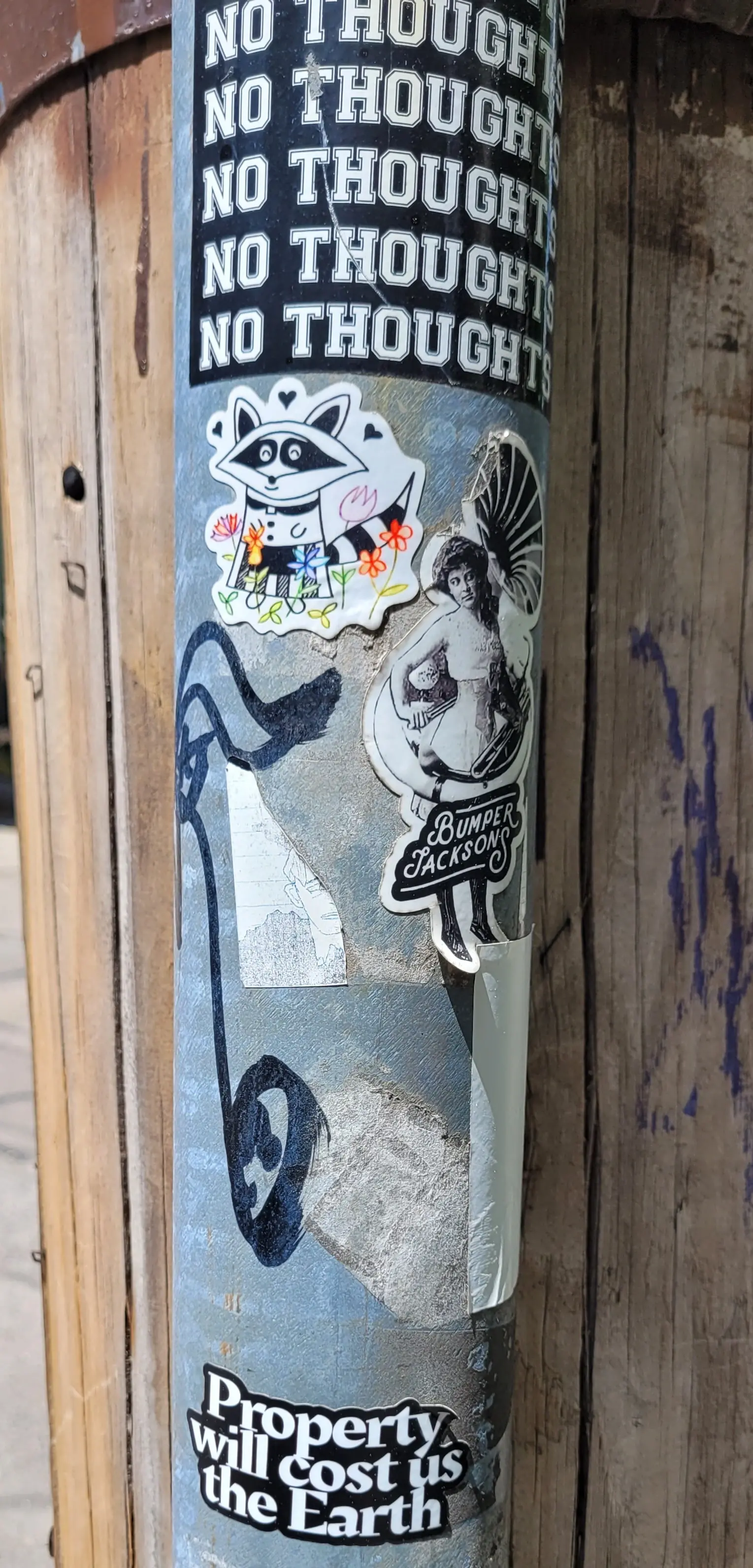
The image shows several stickers attached to a metal pole. Near the center is a black and white cartoon raccoon in a dress surrounded by colorful flowers.
Bee House Update
I posted awhile back after making a home for solitary bees, sharing that it had gotten some use. Its important to replace the sticks annually to prevent parasites from being passed from bee to bee as holes are reused.
Thanks to some winter storms, we had lots of downed branches to clear, so I had no shortage of sticks available for use as future bee housing:
The holes need to be between 5" and 6" deep, so I started cutting the sticks into 6.5"-ish lengths.
This doesn't look like much but it took a lot of eight-foot branches to make these piles.
The next step was drilling holes. Different size bees need different diameter holes, so I read a few guides and picked out a range of drill bits between a metric #2 and a full half-inch (I don't think solitary bees care about unit standardization) to make sure any potential tenants can find a cozy caliber to call home.
I used the drill press to start the holes then used a set of extra long metric bits in a screwgun to get the full length the bees need
This didn't always go perfectly. I didn't break any bits, but sometimes the holes were crooked enough to punch through the side of the stick and I'd set them aside.
Then I just had to bag up what I'd made and replace the sticks in the bee house:
(Background omitted because it's easier than tidying the shop.)
I'd thought I'd made enough sticks for two years, but it took almost all of them to fill the bee house. Glad I prepared as many as I did.
I think I'd call that move-in ready.
One of the still panels from a little rural cyberpunk webcomic I've been working on

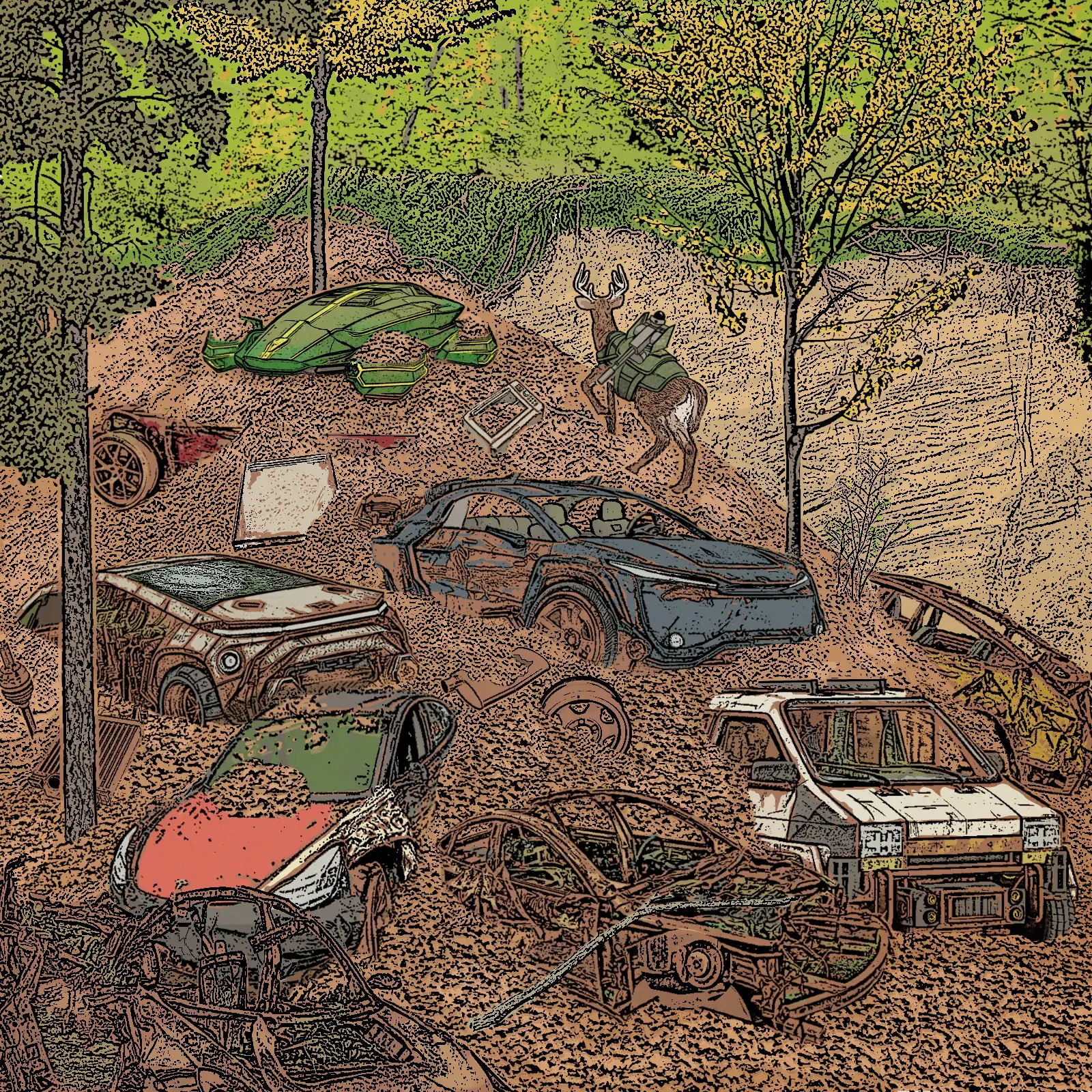
Awhile back I posted that one of my cyberpunk short stories got picked up by an anarchist fiction zine. I was excited because I had this related-but-sort-of-mutually-non-canonical photobash comic ready to go, which played with the same concept but in a different tone.
I don't want to spam this community with my comic weekly or anything, so I figured I'd just share a few still panels, spaced out whenever I get to them in the posting schedule. They're just quiet bits of art between the jokes.
Hopefully that's all okay, and if you do want to read this silly webcomic about a stolen secret service protoptype and the endangered deer it thinks is the president I'm posting it weekly here or here
That's interesting! It definitely has some of the visuals often associated with solarpunk (I'm not really a fan of the sleek plastic metropolis look personally, I much prefer solarpunk to be punk and emphasize stuff like creative reuse, but the visual art in the genre is lousy with this stuff and the game makers executed it well from what the trailer shows). I think there's still room for this to be cyberpunk depending on how real or widely available this area is - if it's some company park or an enclave of the rich, and wealth disparity still exists, I could see it being cyberpunk in content if not aesthetics at least. It does look very cool, thanks for sharing it!
A cool idea for a nautical campaign - a faction of emergency response pirates
Allegato: 1 immagine 💾 Here's my latest #Solarpunk #Thriller #ShortStory! :blobrainbow: A megafreighter shipwrecks next to the Aeolian Islands. The crew abandons the ship and its cargo to its destiny, ecological disaster is inevitable... unless the pirates of the Meteorina can salvage the situat...

I found this story on Mastodon, about a maritime shipping disaster and the first-on-the-scene, questionably-legitimate emergency responders who rescue crew, contain the ecological impacts, and restore infrastructure damaged by a megafreighter crash before the official response can get into gear. And who take a bunch of loot when they leave.
Fully Automated's setting is generally more responsible than the capitalist one suggested in this story, so there might be less of a vacuum for a group like this to fill. But the world is big and varied, and it has a messy history, with plenty of war and strife, in which groups like this could thrive. Some of them may still be around. And some regions might just genuinely need someone to step up and respond to disasters, regardless of legitimacy.
Either way, I think it's a neat concept with decent execution.
One of the things I really like about the 40k universe is the incredible scope of the setting. You really can tell just about any story and it fits somewhere in the setting.
I don't actually know much about necromunda, though I used to love the art and articles about it as a kid. I'm hoping someone else will kick in some recommendations
And seven years seems quite optimistic considering how effectively local governments and committees of concerned NIMBYS have been blocking any new nuclear construction for like, my entire lifetime, at least in the US. Apparently nobody wants a nuclear power plant going up near them and they find a lot of creative ways to jam up the works. I'm not sure we have the time to try to ram dozens of nuclear power plants through those folks while the world is burning.
I could see these walking houses (or their descendants) fitting FA's setting
Between the large swaths of rewilded land in Fully Automated's setting (which is protected from any permanent development/dwelings) and the general availability of high tech stuff, I could totally see slow, wandering, nomadic houses being a thing (for good or ill, depending on who in the setting you ask).
Caliper Fixup

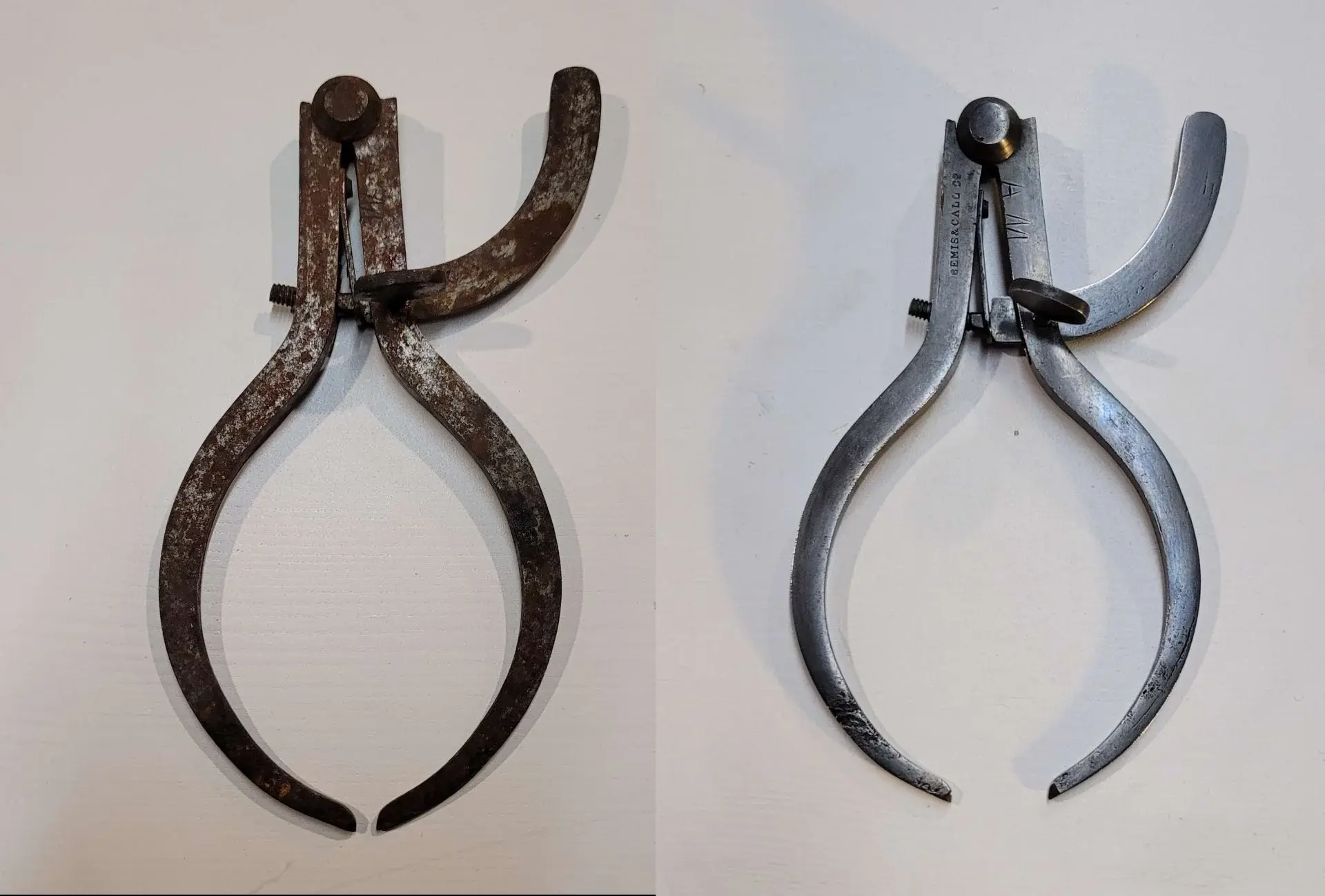
I bought this set of outside calipers at a junk store in my hometown (sort of a consignment, thrift store deal, with lots of old furniture, and the contents of like half a dozen garages right down to the old jars of mismatched screws. I sort of use it like a hardware store).
I like this design a lot, I like the lack of a spring on the jaws, and that you can fasten the little distance measuring arm to the side it measures on, so you can close the calipers around something, tighten that wing screw, then open the calipers to get them back.
They had some surface rust, so I decided to clean them up. The first step was to disassemble them. Not difficult when there's only three pieces involved.
I let them soak in some evaporust for about 8 hours. I really like this stuff, it hits the sweet spot between very effective and not especially dangerous, and it's reusable! They do overestimate how effective it is in their instructions though, so it often takes longer.
! The calipers, straight out of the evaporust. You can already see some text which was hidden before, along with the initials AM from a previous owner.
Now that the worst of the rust had been dissolved, it was time to switch from chemical to mechanical cleaning. I sanded it down with 400 grit emery cloth.
! The calipers with only one side sanded.
As I cleaned up the sides, I found a few neat bits of history:
! Here's some funny nicks up near the joint on one side. I wonder what caused them. And the previous owner's mark on the right side, AM. This is a big part of why I love old tools. I love the history they carry with them, even if I don't know all of it.
! Looking better, but still a ways to go. I was surprised to find that there weren't any markings on the little distance arm. I'd been expecting to find little angle tickmarks or something, maybe even printed numbers, but there weren't any to be seen after the evaporust, or once I started gently sanding off the remaining rust and the black crud evaporust leaves behind.
Once I had most of the rust gone, I switched to steel wool. I didn't want to take too much material off the surfaces, and I felt the more flexible steel wool would hit inside the pitting from the rust better.
The steel wool shined it up quite nicely. And here's a closeup of some of the surface pitting left over by the rust on the left side. The back of these calipers didn't have this kind of damage.
It was tempting to leave it here, but I didn't want the rust to return, so I decided to treat the calipers with cold blue, to provide some protection against oxidation. There are other ways to protect steel, but I like the look and it seems to hold up well enough.
Cold blue always looks a little rough when it first goes on (this stuff is a gel you don't want to get on your hands. You wipe it on, leave it to darken the metal for 60 seconds, and wipe it off again) but a little burnishing with 0000 steel wool will tidy it up:
There we go, still pretty shiny, but not as likely to rust again. Not bad considering how it looked in the beginning. Hope you'd approve, AM.
(I wrote this post for the making/fixing things blog I have on our local movim instance. If you're a slrpnk.net local, your credentials will work on movim automatically!)
Need inspiration on why someone powerful might commit crimes even in a solarpunk society? The Swindled podcast goes in-depth on a wide range of white-collar crimes
Swindled is a true crime podcast about white-collar criminals, con artists, and corporate evil. Watch our latest episodes, our shop & join our rewards program.

I've been thinking about campaigns and discussing possible plotlines with my SO, and while we were talking about options for investigations and the reasons people might commit crimes even in a solarpunk society where everyone has enough, and they reminded me of this podcast which focuses on white collar crimes, their impacts on society, and the investigations around them.
Especially if your players are interested in playing investigators, I think there's a lot of potential in learning about the motivations and tactics of the rich and powerful in everything from taking shortcuts that make unsafe buildings, to illegally dumping chemical waste.
If you'd like to do that learning by listening to an entertaining podcast read by a fellow with a remarkably dry sense of humor, I'd very much recommend it.
Semi related, I'm currently planning a session or short campaign around searching for a decades-old illegal dumping site so it can be remediated, while providing useful inputs to geopolymer manufacturing.
Looking for advice on turning a mountain bike into a cargo bike
I've been riding the same Gary Fisher Hoo Koo E Koo Mountain Bike since my uncle found it in a sandpit and gave it to me to ride while away on my first internship. It was in somewhat rough shape back then, and it's kind of the bicycle of Thesius at this point as parts failed and I found ways to replace them.
I was replacing the front tire and realized I'd like to make this thing into a cargo bike (I currently use it to scout for furniture to restore on trash days, but usually have to ride home and return on foot to grab anything I find, plus I could get groceries). I'm not sure what level of standardization this bike follows and I have no familiarity with cargo bike parts, but I was thinking I'd like to add a Rear Pannier Carrier Cargo Rack and perhaps a large basket on top of that - in fact, I happen to have this homemade welded steel basket I pulled out of a dumpster a couple years ago:
It's 23" long, 12" tall, and 16" wide. I could weld on whatever mounting hardware it needs.
So basically I'm looking for advice on layout and things to add, specific parts if you have any recommendations, is that basket a horrible idea, etc. What traits make for a useful cargo bike, what would work well with this old mountain bike? And thank you for any ideas!!
Solarpunk Workshop

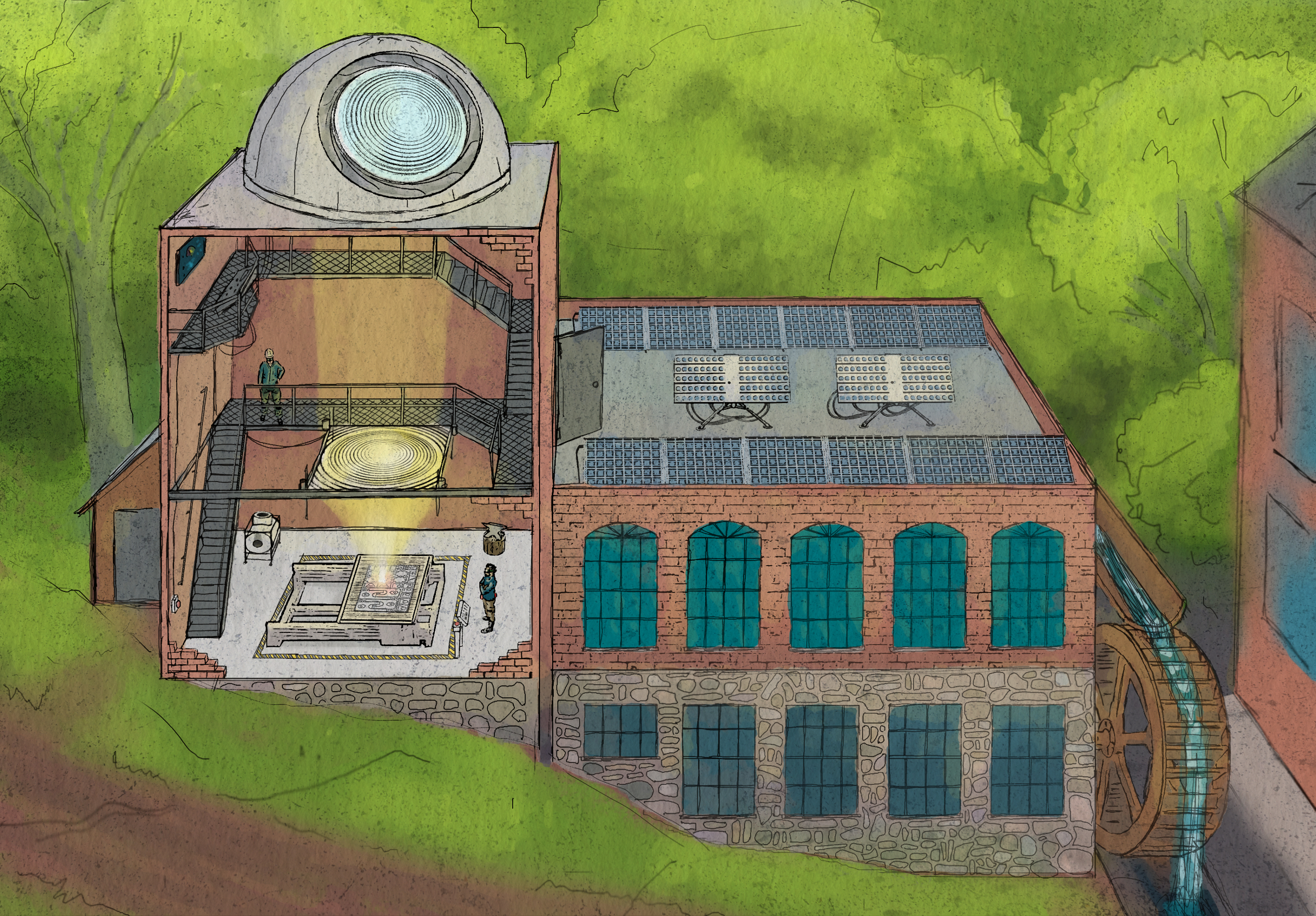
This is one I’ve had on my list for months now, and I finally decided to just go ahead and make it. Back when I was researching solar cookers, solar concentrator, and solar furnaces, I ran into a few really interesting ideas around fresnel lenses. Look them up on youtube and you can find all kinds videos of people melting glass or burning skillsaw blades in half, but the ones that kind of showed me how useful a really-concentrated point of heat could be was this 3D printer for sintering sand into glass objects and this solar rig for smelting zinc or aluminum. Both used fresnel lenses, but were limited by the size of their portable builds.
So here’s my take on something bigger and more permanent, though hopefully still flexible enough to do multiple jobs using concentrated sunlight. The building’s tower houses an observatory-style dome with an irising shutter around a very large fresnel lens. This lens is meant to gather light, but deliberately doesn’t focus it too much, just directs it to another lens, which aims the light straight down. There, on a motorized rig which allows for some adjustment up and down, is the third lens which actually brings it to a searing focal point.
With that focal point reliable and known, the people at the workshop could move several different tools underneath it as necessary, from a crucible for smelting, to a firepot for solar forging, perhaps a glassblowing oven, a 3D sinterer, or the large CNC plasma cutter-style rig shown in the scene.
A set of computers would be set up with light sensors and control over the rotation of the dome, to allow it to track the sun, and the width of the aperture in the shutters, to allow it to regulate the amount of light. The upper limit on the light would be based on how bright the day is, but if they need anything less than full sun, then the opening and closing of the shutters should help with providing consistency. If it starts around half open in full sun and a cloud moves in front of the dome, it might open all the way, then close partially as the cloud leaves. With many minute adjustments, the overall amount of light could remain very consistent down on the ground.
As for the level of focus, I suspect the kerf while cutting would almost definitely be wider than with a modern plasma cutter, but like I said before, people have cut through skillsaw blades with just a lens from a rear-projection TV. So it's possible a larger lens could concentrate even more heat, allowing it to burn through much faster, with less damage to the surrounding material. The tightness of the point would mostly come down to the quality of the lens, as far as I know.
I’ve tried to include a number of controls, caution markings, and red emergency stop buttons, but the one thing I really don’t like about the design as drawn is that it’s not obviously fail-safe. I think ideally there’d be some kind of hanging weight or other mechanism so that when power is lost (not just to the building, as that probably happens fairly often on a less-reliable grid, but to the system’s control unit) the shutters or another light-blocking mechanism slams into place.
Other notes about the scene, I’ve tried to include a diversity of ways to use the sun, the photovoltaic panels for powering the electronics and perhaps some of the tools, a set of fiberoptic solar daylighting systems, which track the sun and pipe light down to the shop floor, along with the simplest version, large windows. This emphasis on daylight should help avoid the risk of electric lights strobing in sync with moving items (such as on a lathe or milling machine) which can cause them to appear stationary and safe to grab onto, though they likely have two sources of light on each just in case. I’ve also included a water wheel, either for power generation, or for the direct motion, to be connected to certain tools or machinery via axles and belts.
Deconstruction crew disassembling abandoned McMansions so the material can be reused - Postcard from a Solarpunk Future
Deconstruction crew disassembling abandoned McMansions so the material can be reused - Postcard from a Solarpunk Future Full post here: https://jacobcoffinwrites.wordpress.com/2024/05/02/deconstruction-crew-disassembling-abandoned-mcmansions-so-the-material-can-be-reused/ #solarpunk #deconstructio...
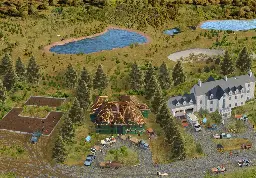
Houses require maintenance. How much and how often depends on the design and its surroundings. They also require occupants - in my brief experience at least, they degrade much faster when they’re left cold and empty than when someone lives there, even if that someone doesn’t fix things. Weather, encroaching water, mold, ice, and animals can all cause compounding damage surprisingly fast.
I think of the solarpunk society I've been depicting as being post-postapoclyptic. They’ve been through the worst of the climate crisis, wars, plagues, and all kinds of shortages, and they’re trying to rebuild better. In some of my previous postcards, I’ve tried to imagine what the rural communities I grew up in would look like transformed into a modern version of how they looked a hundred years ago, with denser villages, trains, and wide stretches of forests and farmland in between. They were set up this way back when because it was practical for people who walked or relied on horse carts to get around day-to-day, and who traveled to use a boat or a steam train for a longer trip. A solarpunk society that doesn’t want to rebuild the infrastructure(s) to produce and maintain personal vehicles, fuel them, and to drive them on, might have to look pretty similar out here.
But what happens to the houses and developments spattered across the land between those villages? Every road with a house a quarter mile from its nearest neighbor, now miles from those hubs of public transit? In a society where public transit is effective, and cars are rare, I think a lot of roads will degrade pretty quickly. They already need tons of maintenance, and that’s with people using them every day, totally dependent on them, grudgingly agreeing to pay for it. It’s not uncommon to live thirty minutes or an hour from your grocery store today, but on badly broken roads, that kind of travel is going to be more difficult and costly. Some people will do it, heck, some will have held out through all the bad times and will stay no matter what else changes. But I suspect a lot of houses will have been abandoned a long time ago.
There’s tons of embodied carbon stored in those structures. In their carefully-refined materials, their transportation, and in the act of construction. Some of those materials might be very difficult to produce for a society that carefully watches its externalities and seeks to do as little harm as possible. And the longer they’re left abandoned, the more they’ll degrade. The structures will become unsafe, the materials will rot or break, or become inaccessible, and in some cases, they’ll pose environmental risks as fuel tanks rust out, chemicals escape their storage, or damaged structures catch fire (even with the powerlines cut upstream, abandoned solar panels or poorly-isolated generators backfeeding into the grid might allow for damage to an abandoned house to cause a fire). This is especially true with modern buildings, particularly the kind of McMansion featured in the scene, with their heavy reliance on petro-products like “structural” foam columns and facades, which will go up like a struck match in the next wildfire.
In some cases, old buildings could be put back into use. Perhaps they’re nearby something the rebuilding society needs. Maybe one development will make for a good farming community, and another the barracks of a logging camp. Maybe one near a river can support trade or fishing. But there will be others that are simply not very useful. They were practical enough for semi-suburban life when gas was cheap, cars were plentiful, and roads were maintained. But in a world where most people have other priorities, live in closer communities, use public transportation, and aren’t interested in rebuilding a car-centric world, these houses don’t make sense. And of course there's the ones in unsafe locations (flood plain, unstable/eroding cliff, etc) where they won’t last no matter what. To that society, deconstruction might be a very practical answer to both the long term threat posed by these structures and to their own building material needs.
Deconstruction is an alternative to home demolition. It means carefully dismantling the constructed components of a house so the materials can be salvaged and reused. Materials are typically removed in the opposite order in which they were installed, to maximize reuse.
By carefully disassembling these structures and hauling the materials back to their communities, they can build and expand for a much lower overall cost (both environmentally and in resources harvested from the world) while removing potential toxin or fire threats. And by filling in their cellarholes and replanting, they can rewild developed land, build better habitats, and restore their local ecosystems.
On top of that, even buildings picked over by looters may be full of usable stuff - furniture, dishes, cooking tools, hardware - which a society with an interconnected library economy could use to meet its needs without producing new items.
So that’s what I’ve tried to depict here, a deconstruction crew carefully disassembling old world structures so that everything, from the windows to the metal roof panels, to the cabinets to the stick framing itself, can be reused elsewhere rather than produced new.
They’ve been working from left to right in this scene, taking each house apart in reverse order to how it was built. Much as with construction, this would require different crews of specialists: inspectors, roofers, carpenters, electricians, plumbers, and others who can safely remove resources without doing unnecessary damage. Once a crew finishes their part of a building, they’d hopefully be able to move on to another one nearby.
They’re also replanting/rewilding the old backfilled foundations, something that would certainly help with breaking up the concrete (eventually). Roots are great at that.
I’m not sure if it’d be worthwhile to use concrete saws to cut at least some of the concrete foundations into construction blocks. It’d certainly help with restoring the site quicker, and it’d be a low-ish carbon source for concrete blocks, but the tradeoffs in labor, transportation, and power for the saw might not be worth it. In that case, they’d probably crack it up with a jackhammer before filling it back in.
There’s a lot of vehicles in this scene, so I should emphasize that these aren’t daily drivers. These are equipment used to haul work crews and construction materials on fairly short trips.
All the big trucks in the scene are old internal combustion engine vehicles converted to run on woodgas. I imagine they burn a lot of the wooden construction debris which were otherwise too small or damaged to be worth salvaging. Perhaps some trucks are even set up with plastic de-refineries and are able to use astroturf lawns, broken plastic siding, or “structural” foam facades as fuel on their trips. This isn’t perfect: it still produces pollution and releases CO2, but if the goal is to salvage as much material as possible, and to prevent it from burning pointlessly in the next wildfire, I could still see an aspirational society accepting that use of it.
As a bonus, woodgas vehicles are often used as generators, so they may be able to serve that role part-time on-site, powering lights and air pumps for confined spaces like basements, and even certain tools. Otherwise they’d probably use portable solar panels.
The other (smaller) vehicles are electric minitrucks and rickshaws.
I imagine that the workers are a mix of specialized crews brought in by the larger community for the scheduled deconstruction, and local volunteers who are working for trade in recovered materials. I imagine a lot of the cargo bikes, Chinese wheelbarrows, rickshaws, and minitrucks belong to them. I figure in place of real roads, the really small villages and isolated homesteads maintain a surprisingly dense web of rough trails suitable for mountain bikes or snowmobiles, which connect to all their neighbors.
Last art thoughts: I have another scene of a golf course and its surrounding McMansions turned into a solarpunk intentional community that I’d like to do, but the scope on that one is big enough it’ll be awhile before I can get to it. At this point, I’m confident I’ll make it though. McMansions, with their pointless, wasteful scale, their cheap construction, their reliance on petro-product materials, and their often vain attempt to spend their way to classiness, seem kind of like the antithesis of solarpunk design to me. Golf courses with their endless, expensive-to-maintain grass monocrop hold a similar, though less severe place in my mind.
If you read all that, thank you! And if you’re a person who owns a building in real life, and you’re thinking about doing some renovations, please consider reaching out to your local chapter of Habitat for Humanity or another group who will do deconstruction, rather than just smashing everything up and throwing it away.
We started a mushroom garden, I'll let you know how it goes!
My SO and I have been planning to start a mushroom garden for awhile now. You can buy these kits…
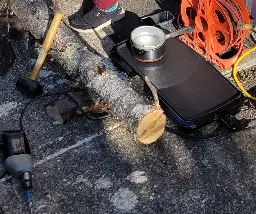
My SO and I have been planning to start a mushroom garden for awhile now. You can buy these kits with mushroom spawn in peg form, and you just drill holes in a log and hammer them in. I'd had big dreams of going along the bike path, adding them to all the dead logs there, until I learned how important it is to properly and thoroughly inoculate freshly-cut logs in order to make sure your fungus of choice is properly established and safe from the competition. This was a bit of a problem as we live in an apartment and the circumstances where I'd cut down a healthy tree are seriously slim, and don't include providing food for mushrooms.
But one of the perks of having a big family is that one of them is always doing yard work, and when one of their birch trees bought it in a recent snowstorm, I was ready to jump in and claim a few pieces. They were happy to get rid of it; they feel grey birch burns poorly - and I was happy to take some because it supposedly turns beautifully on the lathe and it's a suitable medium for shiitake mushrooms.
As an aside, I prepped one thinner piece for use on the lathe. I clamped it to the table and used a draw knife (and a regular carving knife) to strip off the bark, before painting the ends with wax. This helps prevent cracking and checking due to uneven drying from the ends, and spalting/mold/rot from moisture under the bark. Assuming it does as well as the maple and oak I've done previously, it'll be ready to use in a year or two.
Okay, back on to the mushrooms! We bought our kit from a company called Northspore who provided pretty thorough guidance. Their instructions said that logs 4-6" thick and 3-4' long would be good, and one of ours fit that nicely. The instructions also said our log had been cut at about the worst time, after the buds on the branches had begun to swell. So... sorry, mushrooms! Hopefully you'll figure out how to make that work.
They provided a drill bit, instructions on how deep to drill (1") and where (in staggered rows, each hole 4" apart, 2" from their neighboring rows, so it makes diamond patterns). I grabbed a drill and measuring tape and set about drilling all the holes.
(I also cut a couple risers out of a dead log to keep the mushroom log off the ground)
Once all the holes were drilled, we started hammering in the pegs with a rubber mallet.
I don't have great photos of this step (it was a lot of fun) but here's one of the log after we got them all driven in.
The last step was to seal all the pegs in place with melted wax. The kit provided powdered wax and a little fuzzball on a wire handle for applying it. We set up a double boiler on a hotplate and melted the wax while we added the pegs.
We hid our mushroom log in a shady forested spot near the apartment fence. If all goes well, I'll be back with mushroom pictures sometime next year.
Rethinking Maps
cross-posted from: https://slrpnk.net/post/8880368
I wrote this for the Fully Automated community but I think it might be a useful idea for solarpunk writing in general. I mostly learned about writing fiction from reading worldbuilding posts and campaign logs from Tabletop RPG GMs like Shamus Young. (I always found TTRPG story advice to be very practical, compared to whatever resources for writers I'd found back then. Though it does probably explain my worldbuilding-first approach.) Either way, I hope this'll be interesting!
> I've been thinking about Five's excellent comments about states and the borders of a post-state world on one of our previous discussions. And since this Lemmy community is intended partially as a repository of resources for players and GMs, I thought I'd gather up some of the cool maps I've been looking at, and organize them into categories of options/inspiration for anyone who is thinking about what a region outside the more-lore-established Nation of Pacifica might look like. > > ! > > Five suggested a few really cool options, the first of which was the overlapping zones of the historical lands of indigenous peoples. The setting already features a massive, successful Land Back movement, so it would be quite reasonable from a lore standpoint to restore these wherever possible, or to establish a sort of hybrid mix with modern landmarks. This interactive map is also very useful: https://www.npr.org/2022/10/10/1127837659/native-land-map-ancestral-tribal-lands-worldwide > > > ! > > ! > > The next was Watersheds and I really love these maps. To paraphrase Five: in a world where states no longer exist, borders that still have importance are those drawn by nature. People still need to coordinate over land and water management. They give some wonderful world building suggestions though I'd also suggest that as Fully Automated! Is in the transition to a post-state world, but is not there yet, that there's excellent potential for factions, feuds, drama, and plot hooks in the existing states losing relevance to watershed organizations that overlap their territory and authorities, but don't necessarily encompass all of them. > > The cool thing with watersheds is you can aim for huge nation-sized chunks of land, or tiny town-sized boundaries, all depending on your needs. > > > ! > > The last one I'll include is biomes. These are another natural boundary, though often a softer one than the watersheds. > > > And there's no need to restrict yourself to just one new way of redrawing the map. Societies are messy, and often slow to change. It wouldn't be unrealistic to end up with a mix of all of the above, along with existing cities and state or national borders too. Here's one example, though it's alt-history rather than scifi. > > ! > > I hope this is useful, and if someday you're playing the game and redrawing the map, I'd love to see what you come up with!
Rethinking Maps
I've been thinking about Five's excellent comments about states and the borders of a post-state world on one of our previous discussions. And since this Lemmy community is intended partially as a repository of resources for players and GMs, I thought I'd gather up some of the cool maps I've been looking at, and organize them into categories of options/inspiration for anyone who is thinking about what a region outside the more-lore-established Nation of Pacifica might look like.
Five suggested a few really cool options, the first of which was the overlapping zones of the historical lands of indigenous peoples. The setting already features a massive, successful Land Back movement, so it would be quite reasonable from a lore standpoint to restore these wherever possible, or to establish a sort of hybrid mix with modern landmarks. This interactive map is also very useful: https://www.npr.org/2022/10/10/1127837659/native-land-map-ancestral-tribal-lands-worldwide
The next was Watersheds and I really love these maps. To paraphrase Five: in a world where states no longer exist, borders that still have importance are those drawn by nature. People still need to coordinate over land and water management. They give some wonderful world building suggestions though I'd also suggest that as Fully Automated! Is in the transition to a post-state world, but is not there yet, that there's excellent potential for factions, feuds, drama, and plot hooks in the existing states losing relevance to watershed organizations that overlap their territory and authorities, but don't necessarily encompass all of them.
The cool thing with watersheds is you can aim for huge nation-sized chunks of land, or tiny town-sized boundaries, all depending on your needs.
The last one I'll include is biomes. These are another natural boundary, though often a softer one than the watersheds.
And there's no need to restrict yourself to just one new way of redrawing the map. Societies are messy, and often slow to change. It wouldn't be unrealistic to end up with a mix of all of the above, along with existing cities and state or national borders too. Here's one example, though it's alt-history rather than scifi.
I hope this is useful, and if someday you're playing the game and redrawing the map, I'd love to see what you come up with!
Stumbled onto this webcomic on Mastodon, been enjoying it so far, it's got a big backlog and appears to still be going
The last webcomic I recommended was Black and Blue. This one has a lighter tone, and has got some superhero influences, though I think it still falls under cyberpunk.
I've caught up to 2022 and have enjoyed it so far. Apologies if it's better known than I realized, I just stumbled onto it a day ago.
A little green friend


A simple figure drawn on a green painted surface in florescent yellow-green paint. It kind of looks like a seriffed number '1' with feet, an eye, and a little hat(?)

